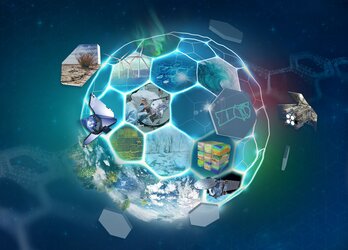Accept all cookies Accept only essential cookies See our Cookie Notice

About ESA
The European Space Agency (ESA) is Europe’s gateway to space. Its mission is to shape the development of Europe’s space capability and ensure that investment in space continues to deliver benefits to the citizens of Europe and the world.
Highlights
ESA - United space in Europe
This is ESA ESA facts Member States & Cooperating States Funding Director General Top management For Member State Delegations European vision European Space Policy ESA & EU Space Councils Responsibility & Sustainability Annual Report Calendar of meetings Corporate newsEstablishments & sites
ESA Headquarters ESA ESTEC ESA ESOC ESA ESRIN ESA EAC ESA ESAC Europe's Spaceport ESA ESEC ESA ECSAT Brussels Office Washington OfficeWorking with ESA
Business with ESA ESA Commercialisation Gateway Law at ESA Careers Cyber resilience at ESA IT at ESA Newsroom Partnerships Merchandising Licence Education Open Space Innovation Platform Integrity and Reporting Administrative Tribunal Health and SafetyMore about ESA
History ESA Historical Archives Exhibitions Publications Art & Culture ESA Merchandise Kids Diversity ESA Brand Centre ESA ChampionsLatest
Space in Member States
Find out more about space activities in our 23 Member States, and understand how ESA works together with their national agencies, institutions and organisations.
Science & Exploration
Exploring our Solar System and unlocking the secrets of the Universe
Go to topicAstronauts
Missions
Juice Euclid Webb Solar Orbiter BepiColombo Gaia ExoMars Cheops Exoplanet missions More missionsActivities
International Space Station Orion service module Gateway Concordia Caves & Pangaea BenefitsLatest
Space Safety
Protecting life and infrastructure on Earth and in orbit
Go to topicAsteroids
Asteroids and Planetary Defence Asteroid danger explained Flyeye telescope: asteroid detection Hera mission: asteroid deflection Near-Earth Object Coordination CentreSpace junk
About space debris Space debris by the numbers Space Environment Report In space refuelling, refurbishing and removingSafety from space
Clean Space ecodesign Zero Debris Technologies Space for Earth Supporting Sustainable DevelopmentLatest
Applications
Using space to benefit citizens and meet future challenges on Earth
Go to topicObserving the Earth
Observing the Earth Future EO Copernicus Meteorology Space for our climate Satellite missionsCommercialisation
ESA Commercialisation Gateway Open Space Innovation Platform Business Incubation ESA Space SolutionsLatest
Enabling & Support
Making space accessible and developing the technologies for the future
Go to topicBuilding missions
Space Engineering and Technology Test centre Laboratories Concurrent Design Facility Preparing for the future Shaping the Future Discovery and Preparation Advanced Concepts TeamSpace transportation
Space Transportation Ariane Vega Space Rider Future space transportation Boost! Europe's Spaceport Launches from Europe's Spaceport from 2012Latest

Pure gold pin for space testing
Thank you for liking
You have already liked this page, you can only like it once!
Although this pure gold pin is not much bigger than the tip of a pencil, it is the ‘pulsing heart’ of ESA’s Low Earth Orbit Facility, LEOX. Part of the Agency’s Materials and Electrical Components Laboratory, based at ESA’s ESTEC technical centre in the Netherlands, this test facility is vital for developing materials capable of withstanding the highly-erosive individual oxygen atoms prevailing at the top of the atmosphere, the result of standard oxygen molecules of the same kind found just above the ground being broken apart by powerful ultraviolet radiation from the Sun.
All missions that orbit less than about 1000 km above Earth’s surface must be designed to resist atomic oxygen. To realistically simulate the low-Earth orbit environment, the LEOX atomic oxygen facility generates atomic oxygen travelling at 7.8 km/s.
Atomic oxygen is not easy to generate on Earth, because it is so reactive. This means that the materials used to make the simulator must be as robust as the materials flown in space. This sturdy gold pin is used to inject tiny pulses of oxygen gas molecules into a vacuum chamber, where the molecules are split into atoms using a powerful laser.
Pure gold, though expensive, is one of the few materials that can resist the combined impact of the laser and the highly erosive atomic oxygen, allowing the simulator to pulse millions of times during each test campaign. The pins do eventually erode and need to be replaced. These pins can’t be found in a local hardware store – engineers had to search far and wide for a reliable supplier. With the help of ESTEC’s Mechanical Workshop, they found a jewellery shop in Italy which offered to manufacture the pins, using their experience supplying miniature mechanical gold parts for clockmakers and other industries.
This image is one of the 99 Objects of ESA ESTEC, a set of intriguing, often surprising artefacts helping tell the story of more than half a century of activity at ESA’s technical heart.
-
CREDIT
ESA-Remedia -
LICENCE
ESA Standard Licence

Juice testing – down to the wire

Securing Aeolus against atomic oxygen

Supernovas blast iron into interstellar space

The Aeolus satellite in launch configuration















 Germany
Germany
 Austria
Austria
 Belgium
Belgium
 Denmark
Denmark
 Spain
Spain
 Estonia
Estonia
 Finland
Finland
 France
France
 Greece
Greece
 Hungary
Hungary
 Ireland
Ireland
 Italy
Italy
 Luxembourg
Luxembourg
 Norway
Norway
 The Netherlands
The Netherlands
 Poland
Poland
 Portugal
Portugal
 Czechia
Czechia
 Romania
Romania
 United Kingdom
United Kingdom
 Slovenia
Slovenia
 Sweden
Sweden
 Switzerland
Switzerland
























